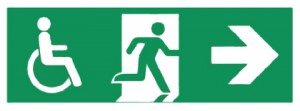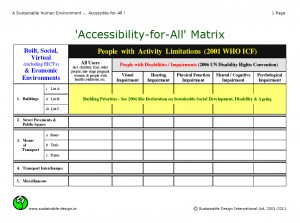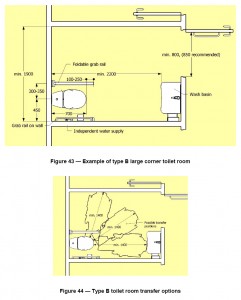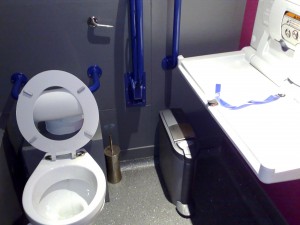2012-03-25: No news about this momentous development, yet, on the International Design and Disability Networks … (why is that ? – are they all asleep out there ?) … but International Standard ISO 21542: ‘Building Construction – Accessibility and Usability of the Built Environment’ was finally published by the International Standards Organization (ISO) in December 2011 ! Even ISO, and national standards organizations, have been slow with an official notification.
This International Standard now provides building users, architects, designers, engineers, builders, building owners and managers, manufacturers, policy makers and legislators with the requirements and recommendations to create a Sustainable Built Environment which is Accessible.
The First Edition of ISO 21542, dated 2011-12-15, represents an agreement reached by strong consensus between different countries all over the world … an agreement patiently constructed and pieced together by a small, dedicated international group of Accessibility Experts. As one of those experts, I am tremendously relieved that this main task has been accomplished … but the process must continue … there are still errors in the document … and the fire safety texts must be expanded.
This is also an agreement which signals that uniform implementation of the main provisions (accessibility-related) in the United Nations Convention on the Rights of Persons with Disabilities (UN CRPD) can commence across the globe, not just in the developed economic regions.
The purpose of this International Standard is to define how the built environment … in particular, public buildings … should be designed, constructed and managed to enable people to approach, enter, use, egress from and evacuate a building independently, in an equitable and dignified manner and to the greatest extent possible.

.
A new international understanding of ‘Building Accessibility’ is hereby established … ‘Access’ (approach, entry and use) can no longer be divorced from ‘Egress’ (in the normal course of events) and ‘Evacuation’ (in the event of an emergency).
The concept of ‘Access’, in isolation, and the role of the ‘Access Consultant’ are, therefore, outdated and obsolete ! And use of the word ‘Escape’, in any context, is to be firmly and rigorously discouraged !!
The intention of this International Standard is to meet the needs of the majority of people. This goal is achieved by agreement on minimum standards of accessibility and usability which are generally accepted to accommodate diversities of age and the human condition.
.
In future … proper emphasis must be placed on Real and Effective Implementation of Accessibility-for-All in the built environment … to meet the needs of real people in all of our communities.
In the past … too many scarce human resources have been diverted into pointless discussions and arguments about accessibility design philosophies. And, particularly in Europe, we have been far too fond of ‘talk’, instead of ‘action’ ! No more !!
.
ISO 21542 : 2011 applies to new and existing buildings.
IF this Standard’s requirements and recommendations are taken into consideration during the earliest stages of New Building Design … the costs of providing satisfactory accessibility and usability in a building will be minimal.
Yes, there are problems with improving the accessibility performance of Existing Buildings … just as there are problems, for example, with improving their energy performance. However … creativity, design flexibility, and an in-depth understanding of the principles of Accessibility-for-All … will ensure that the functional requirements of this Standard are properly met.
Mindful of the 1964 Venice Charter and other similar international instruments … accessibility must also be facilitated in Existing Buildings of Historical, Architectural and Cultural Importance. In such cases, it will be necessary for national authorities having jurisdiction to allow some relaxation of the requirements in this International Standard … as well as to proactively recommend appropriate alternative accessibility measures.
.
This new approach to Accessibility-for-All in the Built Environment … as set down in ISO 21542 … was directly informed by Preamble Paragraph (g) and Articles 9, 10 and 11 of the United Nations Convention on the Rights of Persons with Disabilities (UN CRPD).
At the time of writing … the UN CRPD has been ratified by the European Union (EU) and 109 Other Countries.
An Important Note for Parties to the Convention which is entirely outside the scope of ISO 21542, and standardization generally … but very relevant to the implementation, for example, of Article 11 at national level in the ratifying Countries and EU Member States …
UN CRPD Article 12 – Equal Recognition Before The Law
1. States Parties reaffirm that persons with disabilities have the right to recognition everywhere as persons before the law.
2. States Parties shall recognize that persons with disabilities enjoy legal capacity on an equal basis with others in all aspects of life.
3. States Parties shall take appropriate measures to provide access by persons with disabilities to the support they may require in exercising their legal capacity.
4. States Parties shall ensure that all measures that relate to the exercise of legal capacity provide for appropriate and effective safeguards to prevent abuse in accordance with international human rights law. Such safeguards shall ensure that measures relating to the exercise of legal capacity respect the rights, will and preferences of the person, are free of conflict of interest and undue influence, are proportional and tailored to the person’s circumstances, apply for the shortest time possible and are subject to regular review by a competent, independent and impartial authority or judicial body. The safeguards shall be proportional to the degree to which such measures affect the person’s rights and interests.
5. Subject to the provisions of this article, States Parties shall take all appropriate and effective measures to ensure the equal right of persons with disabilities to own or inherit property, to control their own financial affairs and to have equal access to bank loans, mortgages and other forms of financial credit, and shall ensure that persons with disabilities are not arbitrarily deprived of their property.
.
ISO 21542 : 2011 is available from the International Standards Organization (ISO) at … www.iso.org/
The Official Abstract on the ISO WebSite states …
ISO 21542 : 2011 specifies a range of requirements and recommendations for many of the elements of construction, assemblies, components and fittings which comprise the built environment. These requirements relate to the constructional aspects of access to buildings, to circulation within buildings, to egress from buildings in the normal course of events and evacuation in the event of an emergency. It also deals with aspects of accessibility management in buildings.
ISO 21542 : 2011 contains provisions with respect to features in the external environment directly concerned with access to a building or group of buildings from the edge of the relevant site boundary or between such groups of buildings within a common site. It does not deal with those elements of the external environment, such as public open spaces, whose function is self-contained and unrelated to the use of one specific building, nor does it deal with single-family dwellings, other than those circulation spaces and fittings that are common to two or more such dwellings.
.
.
END










